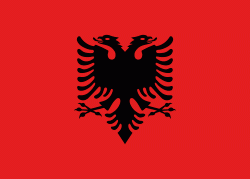Himarë (Bashkia e Himarës)
Himarë (Himara; Χιμάρα, Chimara or Χειμάρρα, Cheimarra) is a municipality and region in Vlorë County, southern Albania. The municipality has a total area of 571.94 sqkm and consists of the administrative units of Himarë, Horë-Vranisht and Lukovë. It lies between the Ceraunian Mountains and the Albanian Ionian Sea Coast and is part of the Albanian Riviera. The traditionally perceived borders of the Himarë region gradually shrank during the Ottoman period, being reduced to the town of Himarë and the villages of the coastline (Bregdet in Albanian), generally including only Palase, Dhermi, Pilur, Kudhes, Vuno, Ilias and Qeparo.
The municipal unit of Himarë is predominantly populated by an ethnic Greek community. The local population is bilingual in Greek and Albanian. In particular the town of Himarë and the villages of Dermi and Palasa, which together account for the bulk of the population of the municipal unit of Himarë, are mainly populated by a Greek population. The villages of Iljas, Lukovë, Kudhës, Pilur and Vuno are inhabited by an Albanian population, while Qeparo is inhabited by both Albanians and Greeks. In the 2011 census, in the former municipality of Horë-Vranisht 83% declared themselves as Albanians and the rest didn't provide a reply. In the former Lukovë municipality the population is mostly Albanian with a Greek minority.
The Himarë region is a strip approximately 20 km long by 5 km wide, covering a total of 132.13 km2, and bounded by the 2000-metre-high Llogara mountains to the northeast (known in antiquity and in the local Greek dialect as the Ceraunian mountains (Κεραύνια Όρη, Keravnia ori, "Thunder Mountains") and the Ionian Sea to the southwest. There are long white sandy beaches and the few hills close to the sea are terraced and planted with olive and citrus trees. The villages of Himarë are perched up high on the spurs of the Ceraunian range in positions which offered natural defences against the nearby Lab Albanians during the Ottoman era. The traditionally perceived borders of the Himarë region gradually shrank during the Ottoman period, being reduced only to the town of Himarë and the villages on the coastline (Bregdet in Albanian).
The municipal unit of Himarë is predominantly populated by an ethnic Greek community. The local population is bilingual in Greek and Albanian. In particular the town of Himarë and the villages of Dermi and Palasa, which together account for the bulk of the population of the municipal unit of Himarë, are mainly populated by a Greek population. The villages of Iljas, Lukovë, Kudhës, Pilur and Vuno are inhabited by an Albanian population, while Qeparo is inhabited by both Albanians and Greeks. In the 2011 census, in the former municipality of Horë-Vranisht 83% declared themselves as Albanians and the rest didn't provide a reply. In the former Lukovë municipality the population is mostly Albanian with a Greek minority.
The Himarë region is a strip approximately 20 km long by 5 km wide, covering a total of 132.13 km2, and bounded by the 2000-metre-high Llogara mountains to the northeast (known in antiquity and in the local Greek dialect as the Ceraunian mountains (Κεραύνια Όρη, Keravnia ori, "Thunder Mountains") and the Ionian Sea to the southwest. There are long white sandy beaches and the few hills close to the sea are terraced and planted with olive and citrus trees. The villages of Himarë are perched up high on the spurs of the Ceraunian range in positions which offered natural defences against the nearby Lab Albanians during the Ottoman era. The traditionally perceived borders of the Himarë region gradually shrank during the Ottoman period, being reduced only to the town of Himarë and the villages on the coastline (Bregdet in Albanian).
Map - Himarë (Bashkia e Himarës)
Map
Country - Albania
 |
 |
| Flag of Albania | |
Albania has been inhabited by different civilisations over time, such as the Illyrians, Thracians, Ancient Greeks, Romans, Byzantines, Venetians, and Ottomans. The Albanians established the autonomous Principality of Arbër in the 12th century. The Kingdom of Albania and Principality of Albania formed between the 13th and 14th centuries. Prior to the Ottoman conquest of Albania in the 15th century, the Albanian resistance to Ottoman expansion into Europe led by Skanderbeg won them acclaim over most of Europe. Albania remained under Ottoman rule for nearly five centuries, during which many Albanians (known as Arnauts) attained high-ranking offices in the empire, especially in the Southern Balkans and Egypt. Between the 18th and 19th centuries, cultural developments, widely attributed to Albanians having gathered both spiritual and intellectual strength, conclusively led to the Albanian Renaissance. After the defeat of the Ottomans in the Balkan Wars, the modern nation state of Albania declared independence in 1912. In the 20th century, the Kingdom of Albania was invaded by Italy, which formed Greater Albania before becoming a protectorate of Nazi Germany. Enver Hoxha formed the People's Socialist Republic of Albania after World War II, modeled under the terms of Hoxhaism. The Revolutions of 1991 concluded the fall of communism in Albania and eventually the establishment of the current Republic of Albania.
Currency / Language
| ISO | Currency | Symbol | Significant figures |
|---|---|---|---|
| ALL | Albanian lek | L | 2 |
| ISO | Language |
|---|---|
| SQ | Albanian language |
| EL | Greek language |















